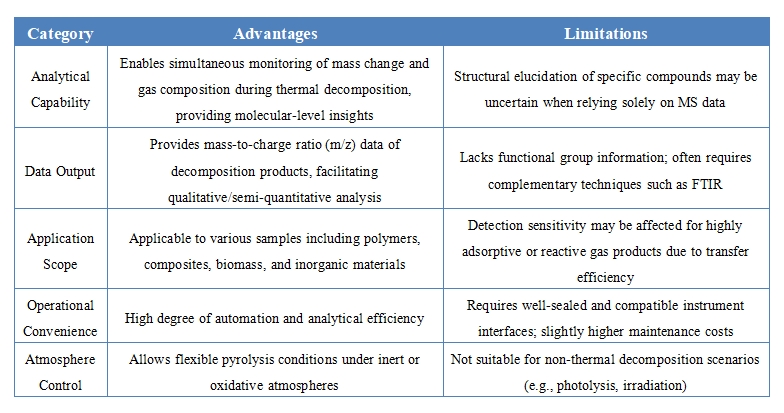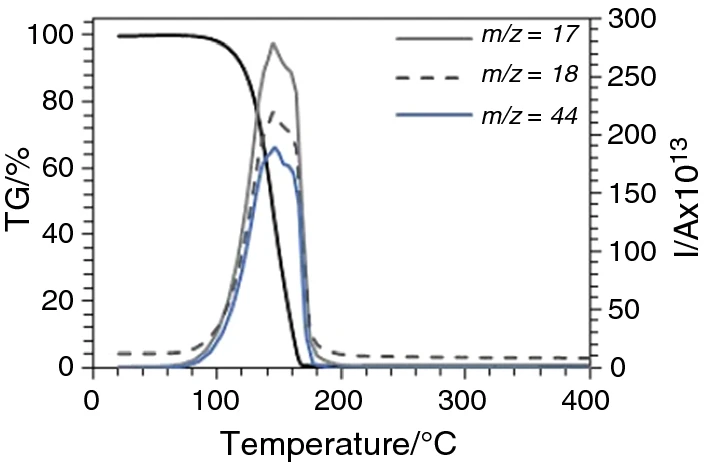Thermogravimetric-Mass Spectrometry (TG-MS) Analytical Service
Thermogravimetric-Mass Spectrometry (TG-MS) analysis is a thermal analytical technique that integrates thermogravimetric analysis (TG) with mass spectrometry (MS), designed to simultaneously monitor mass changes in materials during heating and characterize the composition of the evolved gases. The basic principle involves subjecting a sample to programmed heating, during which thermal reactions such as decomposition, oxidation, or volatilization occur. The TG records the mass loss curve, while the released gases are introduced into the mass spectrometer for ionization and mass-to-charge ratio analysis, enabling high-sensitivity identification of the molecular weight and structural information of the volatile products.
Thermogravimetric-mass spectrometry (TG-MS) analytical service is widely used in studies of the thermal stability and degradation behavior of polymeric materials, pyrolysis product analysis of pharmaceuticals and chemicals, investigation of the release mechanisms of flame retardants or additives, monitoring of surface reactions in catalysts, and identification of harmful gases in environmental materials such as solid waste or soil. This technique holds significant research and application value in fields such as materials science, energy development, environmental monitoring, pharmaceutical industry, and functional materials development.

Lin, L. et al. Analytical Chemistry, 2024.
Figure 1. TG-MS Apparatus.
Services at MtoZ Biolabs
Based on high-performance thermogravimetric analyzers and coupled mass spectrometry platforms, MtoZ Biolabs provides thermogravimetric-mass spectrometry (TG-MS) analytical service capable of simultaneously recording mass changes and mass spectral signals of volatile gases during sample heating in real time. This service includes pyrolysis testing, gas capture, and ion analysis, ensuring the acquisition of gas composition information corresponding to different thermal decomposition stages. It enables high-sensitivity correlation analysis between thermal behavior and molecular structure and is widely applicable for studies such as thermal stability evaluation, degradation pathway analysis, and gas release monitoring.
Analysis Workflow
1. Sample Preparation
Weigh the sample to be tested and place it into the crucible of the thermogravimetric analyzer, ensuring the sample is uniform and free from contamination.
2. Thermogravimetric Analysis (TG)
Heat the sample under a programmed temperature ramp and selected atmospheric conditions (e.g., N₂ or air), recording the mass change as a function of temperature to analyze thermal stability and decomposition behavior.
3. Gas Collection and Transfer
During thermal decomposition, the released gases are transferred in real time through a heated transfer line to the mass spectrometer without condensation or enrichment.
4. Mass Spectrometry (MS)
The gases are detected by the MS to obtain the corresponding mass-to-charge ratio (m/z) information, which is used to identify the molecular composition and structural features of the decomposition products.
5. Data Correlation and Result Output
Integrate TG and MS data to analyze the volatile components associated with specific mass loss events and provide correlations between pyrolysis stages and gas composition.
Advantages and Limitations

Applications
1. Thermal Stability Analysis of Materials
Thermogravimetric-mass spectrometry (TG-MS) analytical service can be used to investigate the decomposition behavior of polymers, composites, and electronic materials during heating, helping to evaluate their thermal stability and safety in use.
2. Monitoring of Volatile Products
This service enables the detection and qualitative analysis of volatile compounds—including trace gases and small organic molecules—released from pharmaceuticals, additives, coatings, and other materials under thermal conditions.
3. Environmental and Waste Assessment
Thermogravimetric-mass spectrometry (TG-MS) analytical service can be applied to analyze the gas composition produced during the thermal treatment of solid waste, biomass, and related samples, supporting the evaluation of pollution risks and bioenergy conversion potential.
4. Catalyst Thermal Behavior Study
By monitoring gases evolved during heating, this service helps to reveal changes in active components and carrier decomposition characteristics in catalysts during thermal treatment or reaction processes.
Case Study
1. Decomposition of Ammonium Salts by Quantitative TG-MS
This study aims to investigate the thermal decomposition behavior of several common ammonium salts using a quantitative thermogravimetric-mass spectrometry (TG-MS) system. The target compounds include ammonium sulfate, ammonium nitrate, ammonium carbonate, and ammonium oxalate. Under controlled atmospheric conditions, the samples were subjected to programmed heating while recording thermogravimetric curves. Simultaneously, mass spectrometry was employed to analyze the types and quantities of gases released during decomposition. The results revealed that different ammonium salts released distinct combinations of NH₃, H₂O, CO₂, NO, and other gases, with release behavior showing clear temperature dependence. The TG-MS system demonstrated high efficiency and sensitivity in tracking the gas evolution pathways during pyrolysis. The study concludes that quantitative TG-MS is an effective tool for gaining in-depth insights into the thermal decomposition mechanisms of ammonium compounds, offering valuable data support for related fields such as environmental science and thermal treatment process optimization.

Zelenková, G. et al. Journal of Thermal Analysis and Calorimetry, 2022.
Figure 2. TG-MS Curves for the Decomposition of Ammonium Carbonate.
FAQ
Q1: Can the Heating Rate and Atmosphere Be Adjusted During TG-MS Analysis?
A1: Yes. TG-MS supports various heating rates (e.g., 5, 10, 20 °C/min) and allows for different atmospheres (such as nitrogen, air, or oxygen) to simulate thermal decomposition under specific conditions.
Q2: What Is the Difference between TG-MS and TG-FTIR?
A2: TG-MS is more suitable for analyzing low molecular weight gases and complex gas mixtures by providing mass-to-charge ratio (m/z) data, which helps identify molecular structures. TG-FTIR, on the other hand, excels at detecting functional groups in gaseous products. The two methods are complementary and can be used together to enhance analytical reliability.
How to order?







